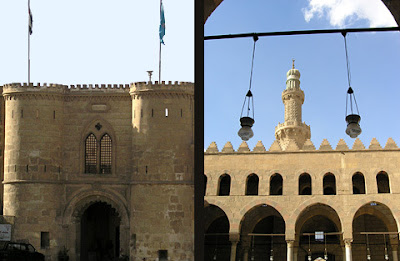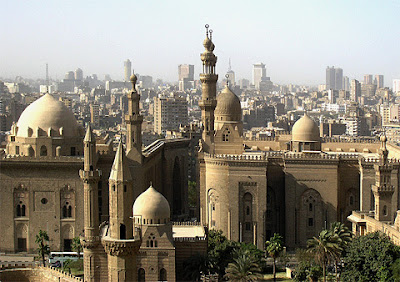Citadel of Saladin
Many tours of the city include the Citadel on their route as one of the main attractions of Cairo. It
is built on the edge of Moqqatam hills and offers a magnificent view of
the city to the south and as far as the pyramids on the west, rarely
clear.
The
Citadel is a medieval fortress that was begun by Salah ed-Din, the last
Fatimid caliphs in 1176 with the intention to shut and fortify the city
against the Crusaders. The other walls of the fortress of origin are best seen from Salah Salem Avenue on the eastern side of the fortress. On the west side the oldest remains are at the western gate (Bab el-Azab), which dates back to 1754. Salah
ed-Din and his successors used the southern half of the castle as a
royal residence, while the northern half was a military garrison.The citadel was home to most of the rulers of Egypt for about seven centuries, each building mosques and palaces in the walls. One of his last sovereign was Mohammed Ali, who took power by massacring 470 Mamluk notables. In
March 1811 the most important people of the Citadel were invited to a
day of feasting by Mohammed Ali, who was then trapped in the passage
carved into the rock of the narrow Bab el-Azab on their way to the
banquet, and had them shot - so the story goes. It was the end of the rule of Egypt Mamaluke.
 |
| Mohammed Ali Mosque |
Mohammed Ali then proceeded to level the most Mamaluke buildings and replace them with his own. His most famous structure is the Mohammed Ali Mosque in the southern wall. There
are also two other mosques in the Citadel today - Ahmed Katkhuda mosque
near Bab el-Azab and the Mosque of Sultan al-Nasir Muhammad (14th
century) on the east side of the southern wall. The most impressive mosque of Mohammed Ali, by far, is also known as the Alabaster Mosque and was built between 1824 and 1857. His
marble tomb is located on the right of the entrance and the whole vast
space is dominated by the massive central dome, 52m high in the roof. This and four smaller domes at the corners are lit by crystal chandeliers circular containing dozens of lamps. The sanctuary on the east coast has a huge chair for reading the Koran. As in all the mosques, the shoes should be left at the door.
 |
| Citadel tower and mosque of El-Nasr Mohammed |
The court also has arches, domes and a pavilion fountain for ablutions and quiet moments can be a very peaceful place. In
the west there is an arcade ornate clock 'Gingerbread', presented to
Muhammad Ali by King Louis-Philippe of France in 1845, in exchange for
the obelisk of Luxor Temple (now the Place de la Concorde ). It seems that France has got the biggest part of the case because the clock has never worked! The
mosque is perhaps best seen from the outside, where you can see the
huge domes and graceful minarets which have become a symbol of Cairo.South
of the Mohammed Ali Mosque is its "Jewel Palace" Qasr el-Gawhara, which
was used as a museum for jewels Khedives after the 1952 revolution.
Although ravaged by fire in 1972, when the thieves tried to steal the jewelry, it is still a museum and contains many elements of royal furniture and portraits.Just south of the el-Nasir mosque is a large tower that covers "Well Joseph" (Bir Yusuf), built by Salah ed-Din. Well-tree is 10m wide and 87m deep and was built by prisoners of war Crusaders. The well is also known as the "good of the snail" for its spiral staircase that descends from the tree at the Nile.
The enclosure of the north of the Citadel has always been the military part of the fortress and has been used as a prison. Today, the region contains three museums. The
Archaeological Museum garden or a garden or a museum, contains a few
pieces of statues and fragments of monuments among resting interesting. The War Museum contains exhibits of military paraphernalia of the Pharaonic era, through the history of Egypt at present. Outside
there are tanks, cannons and other artillery while inside one of the
most interesting exhibits is a chariot from the tomb of Tutankhamun,
displayed at the entrance. The Carriage Museum has a small collection of horse-drawn carriages and horses painted wood 19th century.EntryThe Citadel is on the eastern side of Cairo and can be reached by bus from different parts of the city or taxi. There are two ways to approach it. The Bab el-Azab, you can walk along the outer wall of the new gate of Mohammed Ali and climb the steep trail on the north side. Otherwise, there is parking on the east side of the soft path to the higher levels. Tickets cost 50 EGP the citadel.
Khan el-KhaliliNot
a monument - but a great way to spend an evening browsing or buying
hundreds of shops and stalls selling everything imaginable. The
original building of the famous bazaar was built in 1382 by Amir Garkas
el-Khalili and later became a caravanserai (inn) in the area of
downtown Cairo wealth and commerce for merchants traveling around the world. Today,
the Khan el-Khalili is a maze of alleyways and narrow passages,
sometimes covered, where many artisans work in gold, silver, brass,
leather, glass and stone. There
are shops that will make a shirt or galabeya while you wait, some shops
selling perfumes and incense and many many cafes where you can watch
the world go by. If
you're looking for souvenirs, there are plenty of variety and the
fierce competition, it is advisable to you to exercise your bargaining
skills. Khan el-Khalili is said to be one of the biggest bazaars in the world.
 |
| Khan el-Khallili |
Khan
el-Khalili is located just north of the Citadel and seems to be open
from early morning until the last tourist goes home at night. Some shops may be closed on Friday or Sunday for religious reasons.











No comments:
Post a Comment